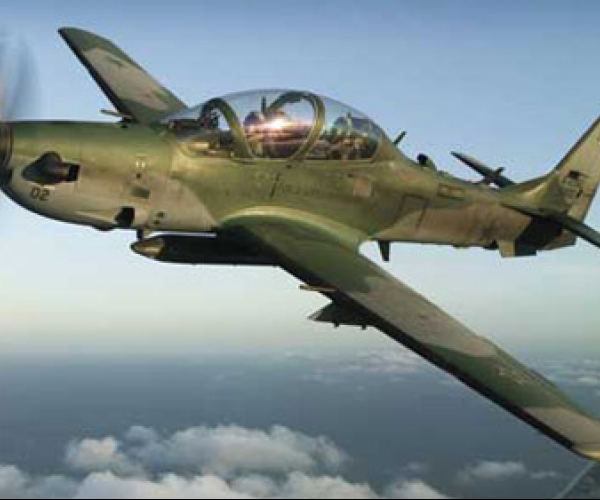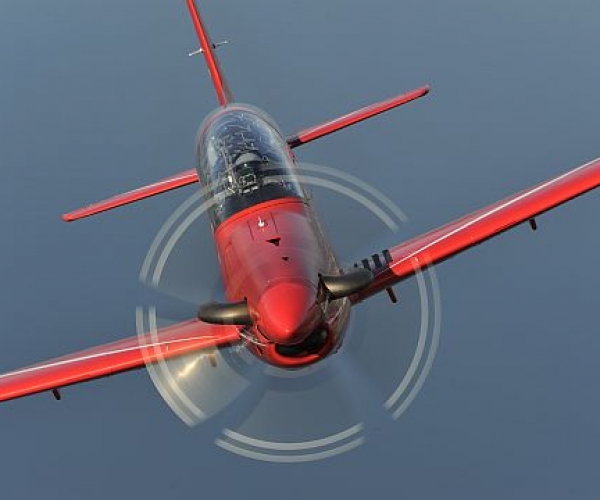Are Armed Turbo-props Here to Stay?
A-29 Super Tucano Attack Aircraft during live fire training in May 2016. Source: AiirSource Military
The rising demand for low-cost, combat-capable aircraft that is able to perform a range of missions in an unchallenged environment, as an alternative to costlier fighter jets will keep armed turboprops in demand.
Turboprops are an extension of basic military trainers or civilian-use planes and are growing in popularity as they are affordable and can perform major missions delivering more power and efficiency at slower flying speeds and costing a fraction that of fighter jets.
Turboprop engines make less noise than jet engines, cost less than jet engines because of high-temperature metallurgy (materials cost and maintenance) and have the least environmental chemistry impact from fuel consumption versus payload.
However, the fly in the ointment is that turboprops are vulnerable to shoulder-fired missiles, anti-aircraft artillery and even light unguided weapons as they fly low and slow. This limits their use to situations where the adversary is not equipped with air defence systems.
A turboprop outweighs armed drones and helicopters in performance as it is able to carry a heavier payload and fly higher and longer than either of them.
Places that now fly them, or are expected to do so, include Brazil, Chile, Colombia, the Dominican Republic, Ecuador, Indonesia, Iraq, Lebanon, Morocco and Venezuela and the United States.

Armed turboprops- Fighter planes for asymmetric warfare
The wars in Afghanistan and Iraq have highlighted the need planes that can fly low and help in better targeting rather than fighter jets that fly high and fast and attack large targets in a challenged environment.
The low logistical requirement of turboprop aircraft makes them suitable for airfields that are too short or rough for jet fighter and attack aircraft, or too dangerous to support with large quantities of fuel.
Embraer had built a propeller-driven plane specially made for the close-in aerial fighting. Famously known as A-29 Super Tucano, it was capable of flying and fighting from less than 1,000 feet above the ground.
The low-and-slow Super Tucano, manufactured in Brazil and completed in Florida, began arriving at a US Air Force base in September 2014, so that American pilots could train Afghans to fly them.
In mid-2015, the US Air Force directed exploration of a future attack aircraft, notionally designated OA-X, which is envisioning a turboprop engine powering the plane.
With potential US Air Force interest in light attack aircraft, a number of manufacturers have put forth existing and potential products for consideration.
Early this month, Sierra Nevada Corporation (SNC) issued a press release on behalf of itself and its partner, Embraer Defense & Security, announcing that they would be sending their A-29 light attack aircraft to the US Air Force’s evaluation. Same month, Textron Aviation sent out a notice that it’s AT-6 Wolverine and Scorpion aircraft were slated to take part in the tests. The project would begin in July 2017 at Holloman Air Force Base in New Mexico.
Nigeria has also sought the A-29 Super Tucano aircraft from the United States. The Trump administration in April this year given a go-ahead for $600 million sale of 12 Embraer A-29 Super Tucano light attack aircraft to Nigeria.

Various Military Turboprop aircraft:
Alenia Aermacchi SF-260:
Powered by a single Allison 250-B17D engine, the SF-260TP is a turboprop version of the SF-260 light trainer / attack aircraft and is designed to provide cost-effective primary and basic training to pilots even in adverse weather conditions. It costs US$1.6m each.
Approximately 900 SF-260 trainers in different versions have been delivered to 27 military customers worldwide, including Italian, Mexican and Philippine air forces.
KAI KA-1:
KA-1, a light attack aircraft indigenously developed by Korea Aerospace Industries (KAI) for the Republic of Korea Air Force (ROKAF), is powered by PT6A-62 turboprop engine driving a Hartzell four-bladed aluminium propeller through an epicyclical speed reduction gearbox. The engine, equipped with multi-stage axial and single-stage centrifugal compressor, has a rated power output of 950hp (708kW).
Currently in service with air forces of Korea, Turkey, Indonesia and Peru, its unit cost US$ 7million.
The other aircraft in operation with the military around the world are Antonov An-32, T-6C, Embraer Tucano, C-130J Super Hercules, P-3 Orion, Pilatus PC-21 and PC-7, and Tupolev Tu-95.
A-29 Super Tucano:
The A-29 is the most widely deployed modern turboprop light attack aircraft in the world, with the most experienced users being Brazil and Colombia. Almost 200 aircraft have been produced with another 200-plus aircraft on order.
The aircraft are in service worldwide from South America to Africa and Asia.
The aircraft can carry rockets, free fall munitions, air to air missiles (AIM-9L class), air to ground missiles (AGM-65 class) and laser-guided bombs including the Enhanced Paveway II—but not the JDAM or Small Diameter Bomb.
Beechcraft AT-6 Coyote:
AT-6 is a single engine turboprop light attack aircraft and uses a Pratt & Whitney Canada PT6A-68 turboprop engine which provides a flat rated 1,100hp (820kW).
The AT-6 can fly at a maximum speed of 585km/h. Its cruise and stall speeds are 500km/h and 185km/h respectively. The range of the aircraft varies between 1,575km and 2,779km. Its service ceiling is 7,620m (with stores) and 9,448m (clean). Its maximum take-off weight 2,948kg.
The AT-6C carries almost as much fuel as the A-29 despite a smaller airframe, and has accomplished weapons tests with the GBU-12/58 Paveway II, guns, guided and unguided 70-millimeter rockets—and Mk-81/82 bombs.
AT-802U:
The AT-802U is made by the American company “Air Tractor Incorporated“, and it is also a turboprop aircraft designed for the light attack role.
The AT-802U is the special armed version of the AT-802 with engine and cockpit armor, a bulletproof windscreen, self-sealing fuel tanks, and structural reinforcements which first flew in 2009, and its official nickname is the “Air Tractor”. Its first and only customer so far has been the United Arab Emirates who bought 10 aircraft which were all delivered in 2011.
IOMAX Archangel:
Archangel, an armed surveillance aircraft manufactured by IOMAX USA, is the Block 3 evolution of the Air Tractor AT-802 agricultural aircraft.
The aircraft can be armed with a variety of air-to-ground missiles and bombs including 12 AGM-114 Hellfire missiles, 10 250lb GBU-58 Mk-81s and six GBU-12 Mk-82 laser-guided bombs, 24 Roketsan Cirit laser-guided missiles, and up to 12 UMTAS AGM laser-guided missiles.
The aircraft also features one centreline hardpoint under the fuselage for mounting additional munitions or reconnaissance / strike / data link pod.
Technical specifications of leading Turboprop Attack Aircraft
|
Aircraft |
Introduction |
Engine |
Gross Weight |
Max. Speed |
Range |
Weaponry |
Radars/Sensors |
Used in Combat |
|
Embraer A-29 Super Tucano |
2003 |
PT-6A-68 turboprop |
7,033 pounds (3190 kilograms) |
370 miles/hr |
700 miles |
20mm cannon below the fuselage, one 12.7mm machine gun under each wing and can also fire 70mm rockets and launch precision-guided bombs. |
Laser INS with GPS navigation system, Brite Star II forward looking infrared (FLIR) |
Afghanistan |
|
Cessna AC-208 Caravan |
1984 |
PT-6A-114/140 turboprop |
8,000 lb (3,629 kg) |
214m/hr |
964 nm |
dual rail LAU-131 Hellfire launcher capability on each wing, AN/ALE-47 electronic countermeasure dispenser, AN/AAR-60 Missile Launch Warning System, AN/AAQ-35 ElectroOptical Infrared Imaging System. |
ATK’s STAR Mission System, with the STAR Compact MPU, 18-inch Avedon color display and integrated fire-control system, MX-15D EO/IR sensor with integrated laser designator and IMU - |
Iraq |
|
AT-6C Coyote |
2000 |
PT6A-68D turboprob engine |
6,300 lb (2,858 kg) |
585km/h |
1,575km-2,779km |
0.50 calibre machine gun pods, air-to-ground missiles like Hellfire and Maverick, AIM-9 Sidewinder air-to-air missiles, munitions including Paveway II / enhanced Paveway II / Paveway IV guided bombs, joint direct attack munition (JDAM), small diameter bombs (SDB) and 2.75in rocket pods.
|
L-3 Wescam MX-15Di sensor suite, Lockheed Martin mission system |
- |
|
IOMAX Archangel |
2013 |
PT6A-67F |
14,800lb(6713 kg) |
242mph |
1553 miles |
Can be armed upto 12 AGM-114 Hellfire missiles, 10 250lb GBU-58 Mk-81s and six GBU-12 Mk-82 laser-guided bombs, 24 Roketsan Cirit laser-guided missiles, and up to 12 UMTAS AGM laser-guided missiles. |
UV Missile Warning System, Radar Warning Receiver, Countermeasure – Flare and Chaff, Gimbaled and Stabilized EO/IR Sensor with Laser Range Finder and Illuminator |
Yemen, Egypt and Libya |
|
AT-802L LongSword |
2010 |
P&W PT6A-67F turboprop |
|
224 mph |
621 miles |
Upto 6200lb of stores carried including cannon pods, conventional drop bombs and rocket pods. |
|
- |
|
Air Tractor AT-802U Surveillance and Light Attack Aircraft |
2008 |
PT6A-67F turboprop |
16,000 lb |
245.1mph |
1499 miles |
2 x .50 cal GAU-19/A three-barrel Gatling guns – 2,900 rounds, 38 x DAGR laser guided rockets, 8 x AGM-114 Hellfire missiles, 250 lb laser-guided bombs, MK82 bombs, GBU-12 Paveway II laser-guided bombs, GBU-39 Small Diameter bomb
|
L3 Wescam MX15Di sensor turret system |
- |

Latest Weaponized version of world’s leading Turboprop military aircraft
Hindustan Turbo Trainer-40 (HTT-40): Being built at HAL to replace the Indian Air Force's ageing HPT-32 Deepak trainers that are currently in service, HTT-40 can be armed with gun, rockets and bombs to perform light combat and counter-insurgency missions.
Powered by Honeywell TPE331-12B turboprop engine, HTT-40 has a maximum take-off weight of 2,800kg, a maximum speed of 450kmph and can reach a maximum distance of 1,000km.
The programme is expected to achieve its operational clearance by 2018.
L3’s OA-8 LongSword: Based on the AT-802 agricultural spray plane built by Air Tractor in Olney, Texas, and powered by a P&W PT6A-67F turboprop, LongSword can carry a variety of gun and rocket pods, and bombs as large as the 500-lb Mk82. Armament load outs capacity reach 6200lbs.
Beechcraft AT-6C Texan II: Starting life as a PC-9 by the Swiss manufacturer Pilatus, the aircraft is significantly modified by Beechcraft to form the venerable T-6 trainer. Termed light attack and reconnaissance variant, AT-6C, by adding integrated weapons systems including .50 cal gun pods, unguided and laser guided bombs, laser guided rockets, and Hellfire short-range strike missiles.
Lockheed Martin introduced the C-130J-SOF, the newest Super Hercules aircraft configured for international military special operations requirements during Paris Airshow 2017. The C-130J-SOF may also be configured for armed over-watch that includes a 30mm gun and Hellfire missiles. In the armed mode, it will be the largest turboprop aircraft configured for an attack role.
Use of weaponized turboprop aircraft in actual combat
In April 2016, four A-29 Super Tucano attack aircraft, manned by Afghan pilots trained in the U.S., were deployed at Hamid Karzai International Airport in Afghanistan to provide security and combat support from the ground units in ground operation against militants group.
The Cessna aircraft (AC-208 and C-208) are also currently used to support Iraqi military operations against al-Qaeda affiliate and Islamic State of Iraq and the Levant (ISIL) forces.









